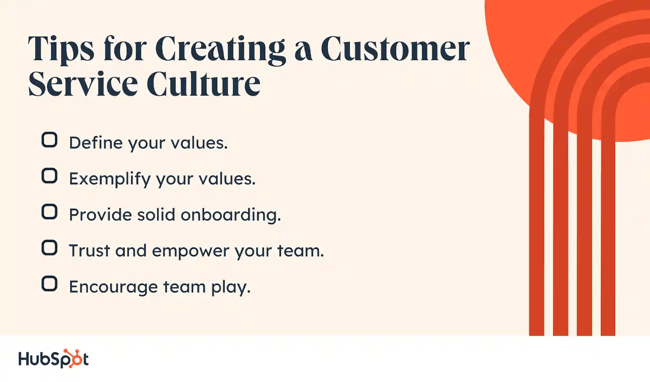In this post, we’ll review what a customer service culture is, how to build one, and review a few examples to inspire your own culture.
Table of Contents
- Customer Service Culture
- How a Customer Service Culture Can Help Your Company
- How to Create a Customer Service Culture
- Tips for Creating a Customer Service Culture
- Customer Service Culture Examples
Customer Service Culture
A customer service culture is about what's happening inside your company. The culture is how your company's visions, values, and mission are upheld by your employees and customers. With a positive customer service culture, your employees will feel empowered to put the customer first.
How a Customer Service Culture Can Help Your Company
Before learning how to create a customer service culture, let’s consider why creating one in the first place is crucial for your organization.
Improves Customer Experience and Sales
At its core, companies build a customer service culture to delight customers.
When employees focus on delivering the best experience to the customer, these customers are more likely to spend more. According to Gladly’s Customer Expectation Report, 72% of customers are willing to spend more with brands that offer an excellent customer experience.
Increases Employee Retention and Engagement
Work culture is one of the leading factors determining whether an employee would leave a company. When you build a healthy customer service culture, you reduce employee turnover and increase loyalty.
With the programs you set to train employees and create camaraderie, you’ll also experience increased employee engagement.
Engaged employees are typically more productive and have better relationships with customers.
Enhances Your Brand Reputation
Gladly’s Customer Expectation Report also mentions that 59% of shoppers would recommend a brand where they experienced good customer service to others in their network — like family and friends.
This sort of positive word-of-mouth marketing has a stronger effect on your brand perception than any ad you might put out by yourself.
Now let’s dive into the actionable steps you can take to create a strong customer service culture that puts the customer first.
How to Create a Customer Service Culture
- Hire for culture.
- Treat your employees well.
- Create camaraderie on your team.
- Build psychological safety on your team.
- Invest in professional development.
- Reward and provide feedback for employees.
- Define and reinforce your culture.
1. Hire for culture.
Looking inward is the first step to creating a sound customer service culture.
In fact, the most tangible thing you can do to create a positive customer service culture is to hire people who embody your values.
When you’re hiring, you should look beyond experience and skills. Instead, ask questions that will help you determine if they’ll embody your existing culture and contribute to it. This means you should ask about the candidates’ values, teamwork experiences, problem-solving skills, and how they prioritize their work.
Shannon Howard at The Predictive Index lists 20 questions you can ask to determine culture fit and culture add.
For example, at HubSpot, our values are HEART (humble, empathetic, adaptable, remarkable, and transparent). Those values play a significant role in who we hire.
What we like: Looking at your hires as whole persons allows you to make the best choices for building your team and fostering your brand culture.
2. Treat your employees well.
Again, one of the only ways to build a strong customer service culture is to evaluate yourself. Ask yourself, “How do we treat employees?” and “If I were an entry-level employee, would I want to work here?”
Happy employees want to perform well, and they want to do right by the company.
But making employees happy is subjective. Everyone’s compensation, workload, and team are different.
An excellent place to start evaluating employee satisfaction is by analyzing the benefits they receive. Do these benefits contribute to your employees’ well-being inside and outside the office?
For instance, a free, onsite yoga class at 7 a.m. each morning may be significant on paper. However, if only 10% of your team attends the class, you’d miss an opportunity to compensate the other 90% adequately.
What we like: Looking beyond the contract and to the well-being of your employees will create long-term satisfaction, increasing employee retention and performance. By seeking to benefit your employees, you ultimately benefit your company.
3. Create camaraderie on your team.
Creating camaraderie on your team is essential to achieve a customer-oriented service culture. For people to do their best work, they have to enjoy the people they work with and view their job as a team effort.
One way to do this is to participate in team-building activities that bond your team. Creating a teamwork environment makes your employees more likely to value the team over the individual, which is the first step to creating a customer-oriented team.
Pro tip: Since syncing everyone’s calendar in a remote/hybrid environment or coordinating travel for large teams can be challenging, you can try virtual team-building activities.

4. Build psychological safety on your team.
We’ve written about building psychological safety before, but it bears repeating.
If your team doesn’t have psychological safety, they won’t feel empowered to try new things or communicate effectively.
This means that people might refrain from speaking up about unique ideas they have or admitting when they’ve made a mistake. To truly empower your team to bring their best selves to work, they must feel safe at work. They should feel safe to make mistakes and learn.
Pro tip: To build psychological safety, you can work on inclusion in your team meetings or conduct team activities meant to help build camaraderie.
With psychological safety, employees will have the freedom to provide constructive feedback. This means you must listen to your employees and take their feedback seriously.
5. Invest in professional development.
Most of these tips are centered around your employees. That’s because they are the ones who have to live and breathe your culture every day for it to reach your customers. For your team to continuously create a positive customer service culture, invest in training so everyone’s on the same page.
Pro tip: Your employees should be knowledgeable about your product or service. To empower them to do this, you should provide continuous professional development opportunities.
6. Reward and provide feedback for employees.
Your customer service culture should incentivize employees to follow through on your values in their interactions with your customers. To do this, reward employees who provide excellent customer service and tell them what they’re doing right.
On the other hand, if employees aren’t quite grasping a concept, provide constructive feedback so they can improve. Doing this will help reinforce what you want your customer service culture to be.
Pro tip: Don’t wait until your team members’ annual performance reviews to give them feedback. Commit to checking in at least twice a year, if not every quarter, about what they’re doing well and what they can do to grow.
7. Define and reinforce your culture.
Not to get too rudimentary, but your customer service culture should be written down. You should have your values, mission, and vision written out and clearly communicated to employees and customers.
What we like: This means your managers and employees will have a guiding philosophy to help them make decisions. Plus, it helps inform customers what you’re hoping to achieve so they can provide feedback.
Tips for Creating a Customer Service Culture

1. Define your values.
To get started, take a look at your values. If you don’t have them written down, develop some. Start by thinking about the type of workplace you’d like to have if you had the best talent and unlimited resources.
Then, parse that down to three to five statements like “My employees feel empowered to do their best work” or “Everyone in the company values continuous learning.”
2. Exemplify your values.
Culture is top-down, not bottom-up. If your leadership team embodies your values, your employees will model them. They’ll be proud of where they work, which plays a prominent role in talent acquisition and retention.
3. Provide solid onboarding.
After hiring candidates who fit with your culture, it’s crucial to provide them with sufficient onboarding so they understand the ropes and feel they have the tools to do their jobs. Also, be sure to host a team event so new hires can feel welcomed and get to know their teammates.
4. Trust and empower your team.
Customer service representatives have to face a lot of heat from customers. Trust that you have made good hires and provided proper training so that you can empower your reps to make the decisions they need to on the spot.
5. Encourage team play.
Make sure everyone feels that they’re on the same side. Instead of each employee just looking out for him or herself, encourage a spirit of camaraderie and a willingness to help a colleague who needs a boost or to celebrate someone’s success (both in and out of the workplace).
Customer Service Culture Examples
Now, you might be wondering, “What does this look like in action?” Let’s review some examples below.
1. HubSpot
At HubSpot, creating a strong customer service culture is important.

That’s why our co-founder, Dharmesh Shah, took the time to write it down in the HubSpot Culture Code.
According to Shah, the HubSpot Culture Code is a perpetual work in progress that gets updated periodically.
“To date, we’ve updated it more than 25 times, and what you see is our latest version. It is a culture of amazing, growth-minded people whose values include using good judgment and solving for the customer,” Shah says. “Employees who work at HubSpot have HEART: Humble, Empathetic, Adaptable, Remarkable, Transparent.”
What We Like
By publishing and talking about our customer service culture, both employees and our customers understand what we stand for. That creates a sense of belonging on the team.
Even candidates for open positions at HubSpot are encouraged to read and share their thoughts on the Culture Code. This resource is a great way for candidates to understand how they can add to the HubSpot culture.
2. Zappos
When I studied Organizational Communication in my undergrad program, Zappos was the first company I researched.
It’s well known for providing excellent customer service, even if that means helping a customer with a problem that has nothing to do with a Zappos order.
Tony Hsieh, the founder of Zappos, says, “It’s about always looking for new ways to WOW everyone we come in contact with. It’s about building relationships where we treat each other like family.”
Hsieh notes that Zappos culture involves teamwork, having fun, and growing personally and professionally.
“It’s about achieving the impossible with fewer people. It’s about openness, taking risks, and not being afraid to make mistakes. It’s about being part of a story that never stops unfolding. And it’s about having faith that if we do the right thing, then, in the long run, we will be a part of building something great,” Hsieh says.
What We Like
Both HubSpot and Zappos have founders who are passionate about their customer service culture. Both companies discuss it and have intentionally created a positive environment for employees and customers.
Hsieh adds, “Unlike most companies, where core values are just a plaque on the wall, our core values play a big part in how we hire, train, and develop our employees.”
3. Slack
Creating a company culture has to be a work in progress. Slack understands this, and they’ve worked to improve their company culture throughout the years.
At Slack, they value diligence, curiosity, and empathy.
Nolan Caudill, the previous engineering chief of staff, says, “At Slack, we want to work with people that have the skills to do their job and the gumption to do it well. They possess great empathy, as designing and building a great product is made up of countless acts of empathy, not only for the users but for those you do the work alongside.”
Caudill also notes “diligence, persistence, an unrelenting bull-headed pursuit of quality” as being a large part of the culture.
What We Like
We like that Slack understands that company culture is something that needs to be intentional because letting culture form unchecked can vary from fair to disastrous. Moreover, it’s clear that they hire for their culture, searching for people who have the qualities and willingness to make Slack an excellent company.
All these companies take culture seriously and have it embedded in their strategies. It’s important to note that these examples can provide inspiration, but they shouldn’t be copied exactly.
You have to look at your company and see what works for you. To really get started on customer service culture, look inward and evaluate how your team functions.
Getting Started
After following the tips we’ve provided to build a strong customer service culture, it’s crucial to do your utmost to continue to maintain and update your culture as needed. Staying too rigid in this ever-changing market wouldn’t always yield the desired results. So be flexible while keeping your employees and customers at the top of your mind.
Editor's note: This post was originally published in July 2020 and has been updated for comprehensiveness.
.png?width=112&height=112&name=Image%20Hackathon%20%E2%80%93%20Vertical%20(37).png)
.webp)






![How to Set 'Smart' Customer Service Goals [Examples]](https://53.fs1.hubspotusercontent-na1.net/hubfs/53/customer-service-goals_3.webp)


